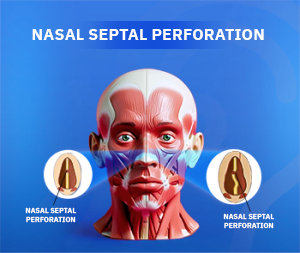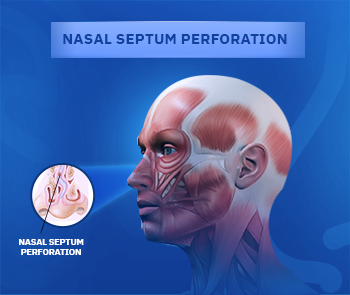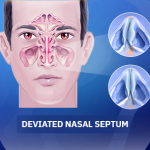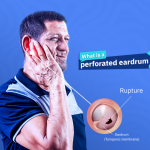Nasal Septal Perforation

A nasal septal perforation is a medical condition affecting the thin structure that separates the right and left nasal cavities. This septum is composed of bone and cartilage, and when it becomes injured or damaged, a hole or perforation can form—most commonly in the anterior (front) part of the cartilaginous septum.
In this article, we’ll cover everything you need to know about nasal septal perforation, including:
A nasal septal perforation is a medical condition affecting the thin structure that separates the right and left nasal cavities. This septum is composed of bone and cartilage, and when it becomes injured or damaged, a hole or perforation can form—most commonly in the anterior (front) part of the cartilaginous septum.
In this article, we’ll cover everything you need to know about nasal septal perforation, including:
- Causes of nasal septal perforation
- Symptoms of nasal septal perforation
- Diagnosis methods
- Treatment options
- When to contact a doctor after surgery
- Prevention tips
Causes of Nasal Septal Perforation
The main causes include:
- Previous nasal surgeries: Septal perforation may occur following nasal septum correction surgery, with an estimated incidence ranging between 0.5% and 3.1%. This is often due to tissue damage during the procedure.
- Frequent nasal cauterization: Used to stop nosebleeds, but excessive cauterization can lead to tissue damage and perforation.
- Nose picking or trauma: Aggressive nose picking can irritate and damage nasal tissues.
- Infections: Both bacterial and fungal infections may result in tissue damage leading to perforation.
- Incorrect use of nasal sprays: Especially decongestant sprays, which may dry out and damage the nasal lining.
- Chemical exposure and chemotherapy: Certain chemicals or cancer treatments can negatively impact nasal tissue health.
- Trauma or injury: Blunt trauma to the nose may cause a fracture or a perforation.
- Chronic diseases: Autoimmune or infectious conditions such as lupus, syphilis, tuberculosis, or some types of cancer can contribute to septal damage.
Symptoms of Nasal Septal Perforation
Symptoms may vary depending on the size of the perforation:
- Small: Less than 1 cm
- Medium: 1–2 cm
- Large: More than 2 cm
Common symptoms include:
- Whistling sound during breathing
- Dry nasal crusting
- Breathing difficulties
- Frequent nosebleeds
- Nasal discharge and mucus
- Nasal pain or discomfort
- Headaches
- Foul smell from the nose
Diagnosis
Diagnosis typically involves nasal endoscopy to visualize the perforation. Additional tests may be recommended to rule out other conditions with similar symptoms, such as:
- Blood tests
- Biopsy of the perforated tissue
Treatment Options
Treatment depends on the size and severity of the perforation and the associated symptoms.
Medical Treatment:
- Maintaining nasal moisture with saline gels or sprays to reduce dryness, crusting, and nosebleeds.
- Avoid petroleum-based products, which may cause lipoid pneumonia if inhaled. Water-based and saline gels are safer alternatives.
Other Treatment Options:
Septal Button (Silicone Implant):
- A small medical-grade device inserted into the perforation to close it.
- Performed under local anesthesia with relatively quick recovery.
- Suitable for small to medium perforations.
Surgery:
- Surgical repair involves reconstructing the septum and closing the perforation.
- Performed under general anesthesia, with a longer recovery period.
- Carries typical surgical risks such as bleeding or infection.
- Important: If the perforation is caused by an autoimmune disease, surgical repair is generally not recommended, even if the disease is inactive.
Factors Affecting Treatment Choice:
- Perforation size: Smaller holes can often be managed non-surgically.
- Symptom severity: Severe symptoms may require surgical intervention.
- Overall health: General health and immune status must be considered before surgery.
When to Contact Your Doctor After Surgery
After surgical repair, it’s important to monitor your condition. Contact your doctor immediately if you experience:
- Heavy nasal bleeding that does not stop easily
- Difficulty breathing, tightness, or sensation of choking
- Increased pain or swelling around the surgical site
- Abnormal discharge from the nose, especially if foul-smelling or discolored
- Redness or swelling on the skin around the nose, which could indicate infection or allergic reaction
Prevention Tips
To reduce the risk of nasal septal perforation:
Keep nasal passages moist:
- Use a room humidifier, especially while sleeping
- Apply saline sprays regularly to prevent dryness
Gentle nasal hygiene:
- Avoid forceful nose blowing
- Clean gently using saline rinses
Manage allergies:
- Follow prescribed allergy treatments to minimize nasal inflammation
Limit nasal decongestant use:
- Overuse of decongestant sprays can dry and damage nasal tissues
- Always consult your doctor before using these products regularly
Conclusion
Nasal septal perforation is a potentially serious condition that can significantly impact quality of life by impairing breathing and causing discomfort. Fortunately, several effective treatment options are available, from conservative medical therapy to surgical correction. Early diagnosis and proper medical care can help prevent complications and greatly improve patient outcomes.





